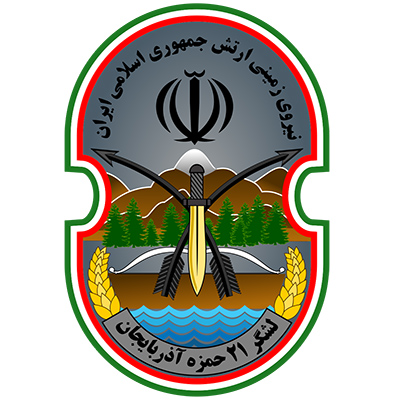Groups, Institutions, Organiza
21st Hamzeh Seyyed al-Shuhada (as) Division
Mohsen Shir-Muhammad
120 دورہ
The 21st Hamzeh Seyyed al-Shuhada (as) Division is one of units of the Iranian Army stationed in the northwest of the country, which played a significant role during the Iran-Iraq War.
The division’s history goes back to before the 1979 Islamic Revolution when the Imperial Guard Infantry Division and the Javidan Guard Brigade were formed.[1] Following the Revolution, both of them were disbanded and reorganized into the 1st Infantry Division and the 2nd Central Infantry Division.[2]
Amid the internal crisis in Kurdistan after the Revolution, a battalion of the 1st Central Division was dispatched to Sanandaj on March 21, 1979, under the orders of Lieutenant General Qarani, then Chief of Staff of the Army. This unit played a crucial role in preventing the fall of the 28th Division’s barracks in the city, marking a turning point in maintaining control over the Kurdistan region and thwarting the complete dominance of anti-revolutionary forces.[3]
During the Kurdistan crisis, various units from the 1st and 2nd infantry divisions were deployed to that region where they remained until September 1980.[4]
On September 4, 1980, 18 days before the onset of the Iran-Iraq War, the units of the 1st and 2nd divisions were merged by order of the Iranian Army Ground Forces Command, forming the 21st Hamzeh Seyyed al-Shuhada (as) Division in Tehran.[5]
With the start of the Iran-Iraq War, units of the 21st Division were deployed to Khuzestan. By October 7, 1980, six infantry battalions, one tank battalion, and four artillery battalions were positioned in northern Khuzestan. They had to defend the region and prevent enemy advances across the Karkheh River near Shush and the Naderi Bridge. On October 15th, Iran’s first counterattack of the war was conducted in this area.[6]
On October 31, 1980, the Iraqi ground forces launched a large-scale offensive to capture the Naderi Bridge, cross the Karkheh River, and advance towards Dezful. Despite five successive attacks, the 21st Division successfully repelled the assault.[7]
The 21st Hamzeh Division played a key role in the series of operations carried out to liberate Khuzestan. In March 1982, the division’s three brigades, operating under Nasr Headquarters, joined Army and Islamic Revolutionary Guard Corps (IRGC) forces in Operation Fath al-Mobin, aimed at liberating territories west of the Karkheh River in northern Khuzestan.[8] Before the operation, a 456-meter tunnel had been dug beneath enemy positions in the area known as the Handali Canal under the supervision of the 21st Division. This tunnel proved instrumental during the initial advance on March 2, 1982.[9] Lasting until March 29th, the operation resulted in seven days of intense combat, during which the 21st Division successfully liberated the Ali-Gerehzad area, the Abu Salbi Khat Hills, and the Radar 4 and 5 installations.[10]
During Operation Beit al-Muqaddas, the 21st Hamzeh Seyyed al-Shuhada (as) Division, comprising its 1st, 2nd, and 3rd infantry brigades and 4th Armored Brigade, operated under the Nasr Headquarters on the left flank of the battlefield.[11] The Nasr Headquarters was tasked with crossing the Karun River in the southern frontline, securing a bridgehead, neutralizing enemy forces, encircling Khorramshahr, and covering the operation’s left flank.[12]
By April 30, 1982, the division’s forces crossed the Karun River at night using floating bridges. Despite fierce enemy resistance, they advanced to the Ahvaz-Khorramshahr Road after intense combat.[13] As the operation progressed, the 21st Division and Nasr Headquarters were tasked with reaching the international border in western Khuzestan and advancing towards Shalamcheh. By reaching northern Khorramshahr, the division helped complete the encirclement that led to the city’s liberation on May 24, 1982.[14]
Furthermore, the 21st Hamzeh Seyyed al-Shuhada (as) Division which held defensive lines in the west of Khorramshahr participated in Operation Ramazan under the Nasr Headquarters.[15] The division was also involved in Operation Preliminary Valfajr (February 1983, northern Chazabeh), Operation Valfajr 1 (April 1983, the area between Ain-Khosh and Chazabeh), and Operation Valfajr 3 (July 1983, Mehran).[16] In February 1984, the division took part in Operation Kheibar, which resulted in the capture of Majnoon Island.[17] One year later, it participated in Operation Badr carried out in the same area.[18]
One of the division’s most significant contributions during the Iran-Iraq War was the artillery support provided to IRGC forces in Operation Valfajr 8, which led to the capture of Faw.[19]
Notable commanders of the 21st Hamzeh Division during the war included Colonel Seyyed Zein al-Abedin Varshosaz, Major General Hussain Hassani Saadi, Brigadier General Behrouz Soleimanjah, Brigadier General Farzollah Shahinrad, and Brigadier General Houshang Nasseri.[20]
Throughout the Iran-Iraq War, 6839 of the division’s forces were martyred, 2670 were injured, and 4130 were taken as prisoners of war by the enemy.[21]
After the war, the 21st Hamzeh Seyyed al-Shuhada (as) Division returned to Tehran. In 1991, it was relocated to northwestern Iran and renamed the 21st Hamzeh Azarbaijan Division. Under the Samen Plan, the division’s brigades became independent in 2011 but remain operationally under the 21st Hamzeh Azarbaijan Division’s command.[22]
Brigadier General Amir Hussain Shafiei is the current commander of
the 21st Hamzeh Azarbaijan Division.[23]
[1] Pejman, Jalal, Foroopashi-ye Artesh-e Shahanshahi (The Collapse of the Imperial Army), Tehran, Namak, 1386, p. 319.
[2] Roozname-ye Ettelaat (Ettelaar Newspaper), 28 Bahman 1357, No. 15786, p. 2.
[3] Norouzi Farsangi, Ahmad, Nagofteh-haee az Zendegi-ye Sepahbod Qarani (Untold Stories from the Life of Lieutenant General Qarani), Tehran, Moassese-ye Farhangi-ye Entesharati-ye Zohd, 1382, Pp. 49, 301, 302.
[4] Hussaini, Seyyed Yaqub va Digaran, Artesh-e Jomhouri-ye Eslami-ye Iran dar Hasht Saal-e Defa Muqaddas (The Army of the Islamic Republic of Iran during the Eight-Year Sacred Defense), Vol. 1, Tehran, Sazman-e Aqidati-Siasi Artesh, 1372, p. 75.
[5] Mofid, Abdolhussain, Bazkhaani-ye Jang-e Tahmili (A Reassessment of the Imposed War), Tehran, Iran Sabz, 1398, p. 51.
[6] Hussaini, Seyyed Yaqub va Digaran, Ibid., Pp. 127, 135.
[7] Soleimanjah, Behrouz, Haftad Saal Khaterat-e Sartip Behrouz Soleimanjah (Seventy Years of Memoirs of Brigadier General Behrouz Soleimanjah), Tehran, Iran Sabz, 1393, Pp. 204–210.
[8] Ibid., p. 215.
[9] Ibid., Pp. 221, 224.
[10] Hussaini, Seyyed Yaqub va Digaran, Ibid., Pp. 262, 266, 267.
[11] Doroodian, Mohammad, Siri dar Jang-e Iran va Araq (A Survey of the Iran-Iraq War), Vol. 1, Tehran, Markaz-e Sepah, 4th ed., 1377, p. 113.
[12] Ibid., p. 119.
[13] Soleimanjah, Behrouz, Ibid., p. 239.
[14] Doroodian, Mohammad, Ibid., Pp. 149, 150, 152, 153.
[15] Hussaini, Seyyed Yaqub, Amaliyat-e Ramazan (Operation Ramazan), Tehran, Iran Sabz, 1393, p. 92.
[16] Jafari, Mojtaba, Atlas-e Nabardhaye Mandegar (Atlas of Lasting Battles), Tehran, Sura Sabz, 35th ed., 1393, Pp. 86, 88, 90.
[17] Hussaini, Seyyed Yaqub, Nabardhaye Saal-e 1362 ta Payan-e 1364 (Battles from 1983 to the Early 1986), Tehran, Heyat-e Maaref-e Jang-e Shahid Ali Sayyad Shirazi, 1389, p. 312.
[18] Ibid., Pp. 445, 451.
[19] Asadi, Heybatollah, Artesh dar Faw (The Army in Faw), Tehran, Iran Sabz, 1387, Pp. 107, 108.
[20] Pasokh-e Koobandeh be Doshman az Diyar-e Azarbaijan (A Crushing Response to the Enemy from the Land of Azarbaijan), Mahname-ye Saf, No. 430, Esfand 1395, p. 27.
[21] Khabargozari Mehr (Mehr News Agency), 16 Tir 1397, www.mehrnews.com/amp/4340840.
[22] Pasokh-e Koobandeh be Doshman az Diyar-e Azarbaijan (A Crushing Response to the Enemy from the Land of Azarbaijan), Ibid., p. 27.
[23] Khabargozari ISNA (ISNA News Agency), 28 Ordibehesht 1400, www.isna.ir/news/1400022820063.





